Editing string text
To edit a text, start the command "ET: Edit Text":
Keyboard |
Textual Menu |
Icon |
<ET> |
"Edit|Draw|Text" |
|
Upon calling the command, the following options become available in the automenu:
![]() <*> Select All Elements
<*> Select All Elements
![]() <R> Select element from list (for named elements only)
<R> Select element from list (for named elements only)
![]() <Esc> Exit command
<Esc> Exit command
Selection, editing the position and attachment, and modifying text parameters are similar to editing other system elements.
Selection of several text, as well as multiple selection of other system elements, can be done by box or by using the options ![]() (selection of all text) and
(selection of all text) and ![]() (selection from the list of the named elements). Besides that, the string text allow subsequent selection of elements by using
(selection from the list of the named elements). Besides that, the string text allow subsequent selection of elements by using ![]() with the <Shift> key depressed. Use of
with the <Shift> key depressed. Use of ![]() in combination with the depressed key <Ctrl> excludes the text from the list of selected for editing.
in combination with the depressed key <Ctrl> excludes the text from the list of selected for editing.
If the selected text is attached to some construction element, this element will be highlighted.
After selecting several text, the following options become available:
|
<P> |
Set selected Element(s) parameters |
|
<Alt+P> |
Copy Properties from Existing Element |
|
<N> |
Set relation with Node |
|
<K> |
Break (kill) relations |
|
<J> |
Merge Text |
|
<Del> |
Delete selected Element(s) |
|
<Esc> |
Cancel selection |
Upon selecting a specific element, the following options are available:
|
<E> |
Edit selected Text |
|
<P> |
Set selected Element(s) parameters |
|
<Alt+P> |
Copy Properties from Existing Element |
|
<Y> |
Create Name for selected Element |
|
<N> |
Set relation with Node |
|
<L> |
Set relation with Line |
|
<C> |
Place Text around Circle |
|
<K> |
Break (kill) relations |
|
<I> |
Select Other Element |
|
<X> |
Explode Text |
|
<D> |
Duplicate Text |
|
<Del> |
Delete selected Element(s) |
|
<Esc> |
Cancel selection |
The option ![]() is used for editing the selected text contents. When the option is called, the text editor window appears on the screen.
is used for editing the selected text contents. When the option is called, the text editor window appears on the screen.
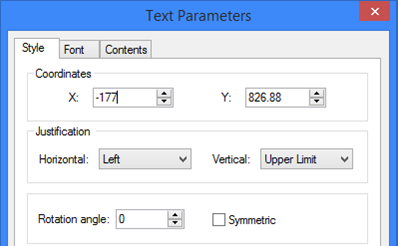
To attach the selected text to a node, line or circle, the same options ![]() ,
, ![]() ,
, ![]() are used as when creating a text. To break and attachment, use the option
are used as when creating a text. To break and attachment, use the option ![]() .
.
The option ![]() allows breaking a text containing several lines into a number of separate elements. In this case, each line of the original text will be converted into a separate “String Text” element.
allows breaking a text containing several lines into a number of separate elements. In this case, each line of the original text will be converted into a separate “String Text” element.
The option ![]() allows creating a copy of the selected text.
allows creating a copy of the selected text.
Modification of text parameters is bound to the option ![]() .. The parameters dialog box appears in the screen. Besides accessing the text parameters and its contents, you can define the text position in the absolute coordinates or by an offset from the attachment node, if the text was attached to a node.
.. The parameters dialog box appears in the screen. Besides accessing the text parameters and its contents, you can define the text position in the absolute coordinates or by an offset from the attachment node, if the text was attached to a node.
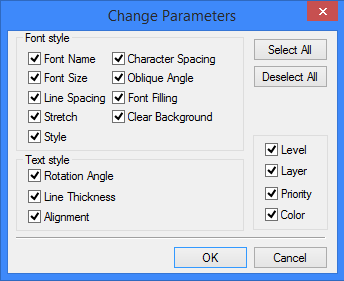
When calling the option while several elements are selected, you will have to first specify the parameters to be modified in the dialog box "Change Parameters". By default, all parameters of the selected elements are subject to editing. Upon specifying the parameters to edit, this standard text parameters dialog box appears.
Editing paragraph text
To edit a paragraph text, use the command "ET: Edit Text":
Keyboard |
Textual Menu |
Icon |
<ET> |
"Edit|Draw|Text" |
|
Selection of several paragraph text, just like multiple selection of other system elements, can be done by box or using the options ![]() (selects all text) and
(selects all text) and ![]() (selection from the list of the named elements). When selected, all rectangular areas of the specified paragraph text are highlighted.
(selection from the list of the named elements). When selected, all rectangular areas of the specified paragraph text are highlighted.
Upon multiple text selection, the following options become available:
|
<P> |
Set selected Element(s) parameters |
|
<Del> |
Delete selected Element(s) |
|
<Esc> |
Cancel selection |
Upon selecting a single element, the following options are available:
|
<E> |
Edit selected Text |
|
<P> |
Set selected Element(s) parameters |
|
<D> |
Add Rectangle |
|
<Y> |
Create Name for selected Element |
|
<N> |
Set relation with Node |
|
<I> |
Select Other Element |
|
<Del> |
Delete selected Element(s) |
|
<Esc> |
Cancel selection |
Text contents editing mode
To begin editing, click ![]() inside the rectangular area or select the option
inside the rectangular area or select the option ![]() .
.
There is yet another way to select a text for editing. When the system is in the command waiting mode, point the mouse to the text to be edited and right click ![]() . In the coming up context menu, select the item "Edit text".
. In the coming up context menu, select the item "Edit text".
Besides that, if the parameter "Transparent' Text editing" is set among the drawing settings (the command ST: Set Document Parameters, the tab "Preferences"), then you can start the text editing mode by clicking the text ![]() (the pointer in this case turns into a textual cursor).
(the pointer in this case turns into a textual cursor).
Modifying parameters of selected elements
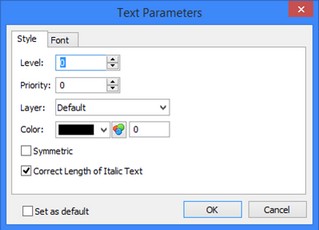
To modify parameters of selected text, use the option ![]() . If the whole paragraph text was selected, then after calling the option a dialog box appears with general parameters of the paragraph text:
. If the whole paragraph text was selected, then after calling the option a dialog box appears with general parameters of the paragraph text:
Level, layer, priority, color – the standard parameters for all T-FLEX CAD elements.
Symmetric. This parameter defines "mirror" text mode.
Account for italic font while formatting. Enabling this parameter allows us to take into consideration the text in italic when placing the elements of fractions, indices and also when formatting the paragraph in the “fit into one line” mode.
By default this parameter is disabled for texts created in T‑FLEX CAD of versions 11 and lower, and enabled for the newly created texts.
The "Font" tab contains several standard parameters. If a rectangular area is selected (see the topic "Editing rectangle" for selection tips), then the option call brings up the dialog box Rectangle parameters:
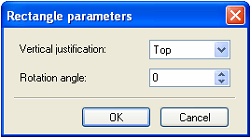
Vertical Justification - sets the vertical text justification inside the selected rectangle. Three justification options are available –Top, Center, and Bottom.
Rotation angle – allows rotating the rectangular area by an arbitrary angle, in degrees. In the case of selecting several elements, upon calling the option <P>, the dialog box appears for selecting theparameters to be edited. The checkmarked parameters will be available for editing in the general text parameters dialog box that follows.
Adding rectangle
The following option adds a rectangle at the end of the list of the existing rectangles:
![]() <D> Add Rectangle
<D> Add Rectangle
If an existing area of the paragraph text being edited was selected before calling the option, then the new rectangle will be inserted in the list before the selected area.
The new rectangle (box) may be automatically created when the content of a paragraph text is edited.
Editing rectangle
To resize an arbitrary rectangular area of a paragraph text, first you need to select it. To do this, click ![]() on the outer side of the rectangle. Now, you can resize it by the mouse.
on the outer side of the rectangle. Now, you can resize it by the mouse.
Automatic deletion of rectangle
It is possible that, as you edit a paragraph text that spans several boxes, the text shrinks so much that the last created box becomes empty. In this case, the system could maintain the empty box, or delete it from the page, or even delete it together with the page on which it is located, provided that this text box is the only object on that page. The specific system actions depend on the settings made in the dialog of the “Parameters of changing Paragraph size” option (the icon ![]() ) in the text content editing mode (see the topic “Entering text content”).
) in the text content editing mode (see the topic “Entering text content”).
Editing text in separate window
Besides the way of editing a paragraph text directly on the drawing, there is a provision for working in the text editor. To start the editor in the text contents editing mode, call the option ![]() . The text editor window will be displayed.
. The text editor window will be displayed.
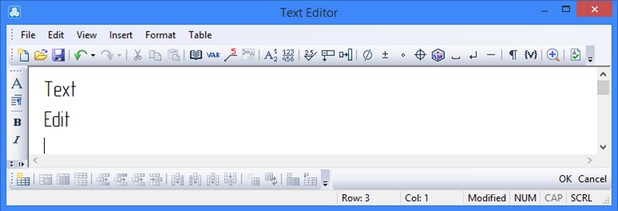
The text editor provides all the text handling options described above (formatting and insertion), plus the option:
![]() Zoom. The displayed text can be zoomed for convenience.
Zoom. The displayed text can be zoomed for convenience.
The text editor also allows working with various text document files. The following formats are supported: T-FLEX Paragraph Text (*.tft), Rich Text Format (*.rtf), Text files (*.txt), DOS Text files (*.txt).
The following options are used for handling files:
![]() New Text <Ctrl+N>. Creates a new document.
New Text <Ctrl+N>. Creates a new document.
![]() Open <Ctrl+O>. Opens a text document.
Open <Ctrl+O>. Opens a text document.
![]() Save as <Ctrl+S>. Saves changes in a file.
Save as <Ctrl+S>. Saves changes in a file.
These options support exchange of text with other text editors. Suppose, for example, that you need to import a Microsoft Word document into a T-FLEX CAD drawing. To do this, use the "Save as" command in Microsoft Word and save a copy of the document in the RTF format. Then, in the T-FLEX CAD text editor open the RTF document using the command "Open file". Thus, you open a copy of the original Word document with all the formatting preserved. You can export text in a similar way. Besides, you can carry over a text from one editor to another by using the clipboard via the commands "Put selection on Clipboard", "Paste Clipboard contents".
The commands for editing paragraph text can be also called from the context menu by right clicking - "Edit" - calls the command "ET: Edit Text"; - "Delete" - deletes the selected text; - "Parameters" - lunches the parameters editing of the selected text; - "Edit text" (for multiline and paragraph text) - executes the command of editing the paragraph text in the text contents editing mode; - "Edit in Dialog" - calls the text editor for editing the contents of the selected text; - "Edit Variables" (if variables exist in the selected text) - starts variable editing mode. |
|
Variable editing mode
To modify the values of the variables inserted in a paragraph text, you do not have to start variable editor. Modifications can be done directly in the text, which is convenient.
This way of editing variables is applicable only to the variables inserted in the text with the flag "Editable as field" checked.
To start variable editing mode, simply point the mouse to the inserted variable and click ![]() . Besides, this mode can be invoked from the context menu by right clicking
. Besides, this mode can be invoked from the context menu by right clicking ![]() over a paragraph text.
over a paragraph text.
The paragraph text containing the chosen variable will be selected as if in the text contents editing mode. However, available for editing will be only the variables inserted in the text and flagged as "Editable as field".
At this moment, the following icons will appear in the automenu:
|
<Ctrl+Enter> |
Finish Variable change |
|
<Ctrl><X> |
Cut |
|
<Ctrl><C> |
Copy |
|
<Ctrl><V> |
Paste |
|
<F6> |
Text… |
|
<Alt+F2> |
Special… |
|
<Ctrl><F3> |
Show “Select from List” buttons |
|
<Ctrl><F2> |
Show non-printing symbols |
|
<Esc> |
Cancel Variable change |
The options ![]() and
and ![]() allow the user to insert the text from the dictionary, indexes, fractions and special symbols into the expression of the edited variable. Both options contain the lists of embedded icons. Any of them can be shown in the automenu. Usually it is the icon of the option which was invoked the most recently.
allow the user to insert the text from the dictionary, indexes, fractions and special symbols into the expression of the edited variable. Both options contain the lists of embedded icons. Any of them can be shown in the automenu. Usually it is the icon of the option which was invoked the most recently.


When using the options of insertion into the expression of the edited variable, the special symbols of formatting by rules adopted for the string text are automatically added (see section “Subscript and Superscript Text. Use of Variables in Text”).
The options ![]() ,
, ![]() ,
, ![]() are provided for handling the selected portion of the current variable value. As the contents of the clipboard are being pasted, the system checks the correspondence between the types of the clipboard contents and the current variable. Therefore, it is impossible to insert a character string into a numerical variable.
are provided for handling the selected portion of the current variable value. As the contents of the clipboard are being pasted, the system checks the correspondence between the types of the clipboard contents and the current variable. Therefore, it is impossible to insert a character string into a numerical variable.
Besides, the system checks for presence of the tab character dividers in the text being inserted. If the text being inserted into the field of a textual variable contains the tabulation characters, it will be processed as follows. The portion of the text before the first tabulation character will be inserted in the current variable. If there are more textual variables in this paragraph text, then the next portion of the clipboard text will be automatically entered in the field of the next variable, and so on until all variables or the clipboard contents are used up.
The option ![]() toggles the display of the graphic buttons for selecting from the predefined list of values.
toggles the display of the graphic buttons for selecting from the predefined list of values.
The option ![]() toggles the display of the formatting marks (tab, new line, etc.) in the text being edited.
toggles the display of the formatting marks (tab, new line, etc.) in the text being edited.
To confirm the changes you have made, press the option ![]() or click the mouse outside the text area. The option
or click the mouse outside the text area. The option ![]() allows quitting the mode without saving the entered changes.
allows quitting the mode without saving the entered changes.

A provision is made for the variables with a predefined list of values stored in a file for editing or adding values to the list without entering the variable editor. Simply right click ![]() and select the respective item in the coming up context menu.
and select the respective item in the coming up context menu.